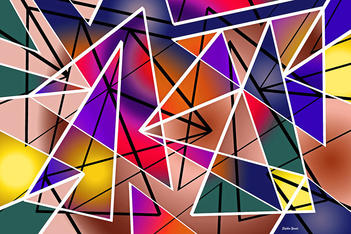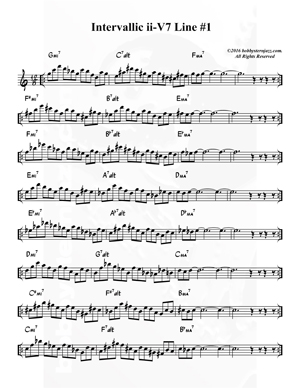Playin' the Angles!
An Angular, Intervallic ii-V7-I Line
 "Angular" by Stephen Younts
"Angular" by Stephen Younts The line's angularity is due to the absence of any consecutive 2nds (Maj. or min.), with the bulk of its interval content being comprised of different qualities of 3rds and 4ths.
This, however, is not a line built on a four or five note scale. Rather, the ii chord contains 6 out of the 7 diatonic note choices from the dorian mode, while the V7 contains all 7 from Melodic Minor (altered scale).
One of the beauties of this line lies in observing how, while moving from the ii to the V7, the scale tones become altered on the dominant side, while the integrity of its shape remains intact.
The time signature is 12/8, felt as 4 dotted quarters (same as a 4/4 triplet feel). Each measure is comprised of four 3 note groupings.
In Line #1, measure #1, groups 1, 2 & 4 are inversions of 027 trichords (Maj. scale steps 1-2-5); the exception being group 2, which is a root position min. triad. A trichord is a three note grouping defined by the distance, in semitones between each note, from its root, which is "0" to the other two member tones.
eg.: F = 0, G = 2, C = 7. If we were to put the F on top (G-C-F, ie. two P4ths) we have a first inversion 027 trichord, which happens to be the initial grouping in measure #1.
It's possible to build 5 different 027 trichords from a Major Scale. In F Maj:
F-G-C, G-A-D, Bb-C-F, C-D-G, D-E-A. The highlighted bottom notes spell out a Bb Pentatonic Scale (IV Mode). In a Major Scale, the relationship between P4s (of which there are 6), 027s (5), and Maj. Pentatonics (3) is intertwined & inescapable (like white on rice; spots on dice, etc.).
Intervallically and directionally, measure #1 also looks like this:
up: P4 - P4 | down: m3 - M3 - m3 | up: P4 | down: M2 - P4 - m3 | up: P5 | down: M2 / m3
are present.
Melodic Minor - and therefore the altered scale - has a unique interval make-up consisting of four P4s, a pair of tritones, and a diminished 4th (which sounds and functions, in most cases, as a Maj. 3rd).
Because of this, the harmonically neutral 027 trichord does not really capture the sound of an altered dominant 7th chord, even though the Melodic Minor system has 3 of them.
eg. in C# Melodic Minor (measure #2) the 027 trichords would be: C#-D#-G#, F#-G#-C#, G#-A#-D#. So in measure #2, A#-G#-D# is the sole 027 in the mix (in the third grouping, in 1st inversion).
Here is the interval breakdown for bar #2 (C7alt):
up: #4 - P4 | down: m3 - M3 - M3 | up: P4 | down: M2 - M3 - M2 | up: P4 | down: M2 / up: m3
Here's measure #1 once more for a side by side comparison:
(up: P4 - P4 | down: m3 - M3 - m3 | up: P4 | down: M2 - P4 - m3 | up: P5 | down: M2 / m3)
I count 5 small interval changes (4 by half step; 1 by whole) and 1 directional change. The shape lives on!
Here's how the 4 bars might look when stacked vertically (with the b5 omitted from the dominant):
G-7 C7alt F Maj7 #11


 RSS Feed
RSS Feed









